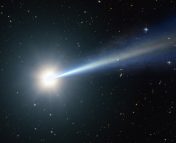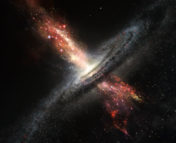Paper Title: The close environments of accreting massive black holes are shaped by radiative feedback
Authors: Claudio Ricci et al.
First Author’s Institution: Instituto de Astrofísica, Facultad de Física, Pontificia Universidad Católica de Chile, Casilla 306, Santiago 22, Chile
Status: Accepted to Nature. Open access on arXiv.
AGN Space Trip
Swirling streams of matter rapidly funnel onto the core of a supermassive galaxy. Wandering stars are tidally disrupted by a central black hole’s voracious appetite. Neighboring gas and dust amalgamate with the stellar matter, as they too are siphoned from their stable orbits and cast towards these inner galactic depths.
Such is life near Active Galactic Nuclei (AGN), which operate like cosmic engines, violently exchanging the gravitational energy of accreted material into powerful feedback (i.e. radiation, jets, and winds).
Obscured Dilemma
Today, we consider the environments closest — few to tens of parsecs– to the action! In these volatile regions, most AGN are obscured by thick columns of circumnuclear dust and gas. The dilemma, though, is that the fundamental nature and evolution of this intervening material remains uncertain. Might the thickness of this obscuring material be linked to AGN luminosity, feedback, and/or maybe the gravitational potential of the black hole itself?
The authors of today’s paper use an unbiased sample of 392 hard-X-ray (14 – 195 keV) selected AGN (median redshift of z ≃ 0.037), observed with the Swift Burst Alert Telescope survey, to find out! The sample contains column density (i.e. the number of hydrogen atoms per square centimeter; NH), X-ray luminosity and black hole mass measurements; which make it ideally suited for elucidating the properties of the obscuring material.
The Thick of It
A critical step in this pursuit is to first understand the relationship between two important parameters: the covering factor and the Eddington ratio (λEdd). The covering factor traces how obscured a source is – it is the fraction of the sky covered by photoionized gas clouds as seen from the black hole. λEdd is a bit more challenging. Effectively, it is a proxy for the accretion efficiency of an AGN (higher λEdd value = higher accretion rates). It is defined as the ratio of the AGN bolometric luminosity (total luminosity across all wavelengths) over the Eddington limit (the luminosity when radiation pressure from an accreting black hole balances gravity). Once the Eddington limit is breached, radiation reigns supreme and infalling material is blown away.
That’s not all, though. The authors also differentiate their sample into Compton-thick and Compton-thin batches (see this awesome Astrobite for more on the differences). Essentially, X-rays produced via inverse Compton scattering can be emitted from the hot corona that surrounds an accretion disk and be absorbed by a torus of neutral hydrogen. If NH is ≥ 1024 cm-2, then most X-rays are absorbed and the gas is deemed “Compton-thick”. On the other hand, if 1022 cm-2 ≤ NH < 1024 cm-2, then the gas is considered to be ‘Compton-thin”. Separating the two in this analysis is useful for constraining how varying environments are impacted by λEdd variations.
Clear the Dust
Figure 1 showcases one of the paper’s key findings – the fraction of obscuring material steeply declines as the Eddington ratio approaches the Eddington limit for Compton-thin AGN. This suggests that radiation pressure dramatically influences AGN obscuration in this sample. The authors reason the following: the fraction of obscured sources is moderate (0.4) when the black hole is inactive; then, as accretion ramps up, gas and dust are “puffed up”, which elevates obscuration fractions; finally, the AGN expel most of the obscuring material when the radiation pressure overcomes the gravitational force (i.e. the Eddington limit is met).
Figure 1: Relation between the fraction of obscured Compton-thin AGN (1022 cm-2 ≤ NH < 1024 cm-2) and the Eddington ratio. The shaded areas are 1σ confidence intervals. The figure shows that the obscuring material is cleared near the expected Eddington limit for dusty gas (at NH = 1022 cm-2), where radiation pressure begins to dominate the gravitational force. [Figure 1 in paper]
In addition, another important result from the paper is presented in Figure 2 – X-ray luminosity does not influence obscuration. The author’s first divide the Compton-thin AGN into two samples: one with sources that are below the approximate Eddington limit expected for dusty gas (NH = 1022 cm-2; Log(λEdd) < -1.5), and one with sources that are above it (Log(λEdd) > -1.5). Then, they compare the fraction of obscured sources from these two populations with the intrinsic (absorption corrected) X-ray luminosity of each source. Surprisingly, they discover nearly zero correlation. This is fascinating! This implies that the total high-energy X-ray emission from the host galaxy is essentially negligible in regulating AGN obscuration. From this insight, the authors infer that the bulk of the obscuring material must necessarily be located within the region where the gravitational potential of the black hole dominates over that of the host galaxy. This zone, the “radius of the sphere of influence”, is estimated to be 1.5 – 64 parsec for supermassive black holes between 106 – 109 M⊙.
Figure 2: Relation between the fraction of obscured Compton-thin AGN and X-ray luminosity for sources that are below the expected Eddington limit for dusty gas (blue data points; Log(λEdd) < -1.5), and above it (orange data points; Log(λEdd) > -1.5). The shaded regions correspond to 1σ confidence intervals. The figure shows that X-ray luminosity has little impact on the fraction of obscuration. [Figure 2 in Paper]
The Big Picture
“What about the Compton-thick AGN?”, you might be inquiring. The authors did not neglect these! They also measured how obscuration changes with λEdd for these. Figure 3 displays the intriguing results – the obscuration of Compton-thin material steeply decays near the Eddington limit (as shown in Figure 1). However, the Compton-thick obscuration remains nearly unchanged over the same range of λEdd. Dividing their sample again into pre and post-Eddington limit populations, they reveal that before the Eddington limit is reached, the covering factor is about 85% (64% ± 5% Compton-thin and 23% ± 6% Compton-thick). After, the covering factor drops to about 40% (19% ± 4% Compton-thin and 22% ± 7% Compton-thick) . The Compton-thick covering factor remains nearly unchanged. One possible explanation for this is that as the column density increases, so too does the Eddington limit, due to the larger amounts of material that radiation pressure needs to push away. This suggests that much higher accretion rates are needed to clear the Compton-thick material.
Figure 3: Relation between the covering factor and the Eddington ratio for Compton-thin and Compton-thick material. a) the black solid curve shows the covering factor for Compton-thin obscuration. The shaded yellow region corresponds to the fraction of Compton-thin material. The black dashed curve shows the covering factor for Compton-thick obscuration. The shaded blue region corresponds to the fraction of Compton-thick material. b) schematic representation of the Compton-thin and Compton-thick material surrounding AGN for a range of Eddington ratios (which are below and above the approximate Eddington limit expected for dusty gas). The figure shows that Compton-thick material is marginally impacted by increases in the Eddington ratio, which is likely due to their higher Eddington limits. [Figure 4 in Paper]
Resolved Matter
Today’s paper offers us an intimate view of the dynamic environments surrounding AGN. Using X-ray observations of nearly 400 AGN, the authors show that radiation pressure is the dominant mechanism regulating the evolution of thick columns of circumnuclear gas and dust that encircles the majority of AGN. These cosmic engines churn in matter, expel torrents of feedback, “puff up” gas and dust, and ultimately blow it out once the Eddington limit is reached. For those with the highest column densities, even higher rates of accretion are needed.
The authors of today’s paper remind us of the turbulent nature of the universe, and march us closer towards understanding its tantalizing depths.
Image Credit: NASA/JPL-Caltech
Editor: Lukas Zalesky




